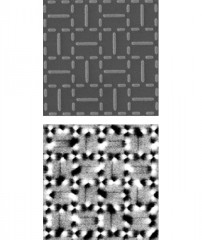Artificial Spin Ice: A New Playground to Better Understand Magnetism

Image courtesy of Nature Physics 10, 670, 2014 Scanning electron micrograph (top) shows the arrangement of iron-nickel nanomagnets for the newly developed “shakti” artificial spin ice lattice. In the lattice, 2, 3, and 4 nanomagnets meet in periodic arrays. Magnetic force microscope image (bottom) shows the poles of the nanomagnets (dark and light contrast).
The Science
Newswise — For the first time, nanomagnet islands or arrays were arranged into an exotic structure (called “shakti”) that does not directly relate to any known natural material. The shakti artificial spin ice configuration was fabricated and reproduced experimentally. The arrays are theoretical predictions of multiple, or degenerate, ground states that are characteristic of complex frustrated magnetic materials.
The Impact
Complex nanomagnet arrays with exotic geometries can be designed and fabricated to exhibit desired physical phenomena and subtle effects. The results open the door to experiments on other artificial spin-ice lattices, predicted to host interesting phenomena. The phenomena are associated with the design of the exotic lattice structures where the topology governs the physics and properties of the material.
Summary
Artificial spin ice is a class of lithographically created arrays of interacting ferromagnetic nanometer-scale islands. Researchers created artificial spin ice as a means to investigate complex magnetism and the related physics in a material that could be tailored to precise specifications and imaged directly. Because of the large magnetic energy scales of these nanoscale islands, a special, newly developed thermal treatment is required to achieve the magnetic ground state. In this research, iron-nickel nanomagnets were fabricated in shakti arrays, a structure with 2, 3, and 4 nanomagnet islands meeting in periodic arrays (resulting in vertexes with 2, 3, and 4 coordination numbers). Then, the structure underwent a thermal treatment by heating it above the Curie temperature (the temperature at which the nanomagnets become magnetic). In this manner, the artificial spin ice achieved unprecedented thermal ground state ordering of the magnetic moments. In these investigations, the shakti spin ice lattices were used to experimentally confirm the ground states of the lattice predicted by Monte Carlo simulations and to study the dynamics and charge screening effects for the system.
Funding
DOE Office of Science, Basic Energy Sciences program. Lithography was performed in part with the support of the National Science Foundation National Nanotechnology Infrastructure Network. Work performed at the University of Minnesota was supported by the European Union Marie Curie International Outgoing Fellowships.
Publications
I. Gilbert, G. W. Chern, S. Zhang, L. O’Brien, B. Fore, C. Nisoli, P. Schiffer, “Emergent ice rule and magnetic charge screening from vertex frustration in artificial spin ice.” Nature Physics 10, 670 (2014). [DOI: 10.1038/nphys3037]
S. Zhang, I. Gilbert, C. Nisoli, G.W. Chern, M.J. Erickson, L. O’Brien, C. Leighton, P.E. Lammert, V.H. Crespi, P. Schiffer, “Crystallites of magnetic charges in artificial spin ice.” Nature 500, 553–557 (2013). [DOI: 10.1038/nature12399]
Contact Information
Kristin Manke
kristin.manke@science.doe.gov
Media Contact
More Information:
http://www.science.doe.govAll latest news from the category: Materials Sciences
Materials management deals with the research, development, manufacturing and processing of raw and industrial materials. Key aspects here are biological and medical issues, which play an increasingly important role in this field.
innovations-report offers in-depth articles related to the development and application of materials and the structure and properties of new materials.
Newest articles

Combatting disruptive ‘noise’ in quantum communication
In a significant milestone for quantum communication technology, an experiment has demonstrated how networks can be leveraged to combat disruptive ‘noise’ in quantum communications. The international effort led by researchers…

Stretchable quantum dot display
Intrinsically stretchable quantum dot-based light-emitting diodes achieved record-breaking performance. A team of South Korean scientists led by Professor KIM Dae-Hyeong of the Center for Nanoparticle Research within the Institute for…

Internet can achieve quantum speed with light saved as sound
Researchers at the University of Copenhagen’s Niels Bohr Institute have developed a new way to create quantum memory: A small drum can store data sent with light in its sonic…





















